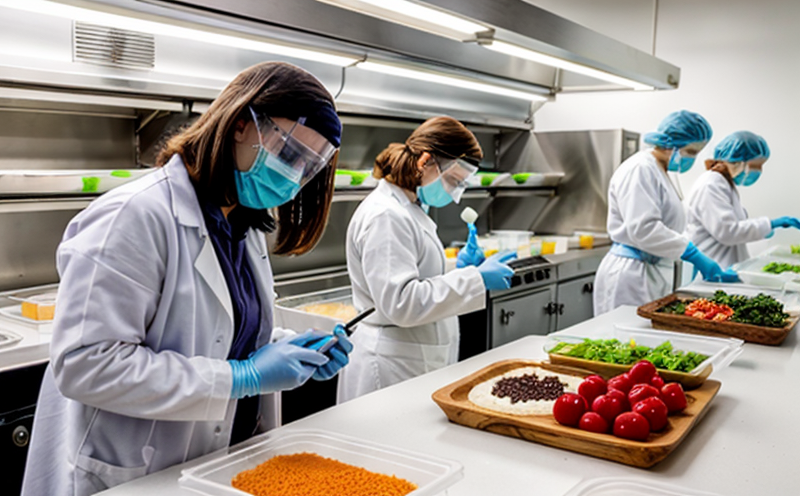AOAC 2015.02 Vibrio parahaemolyticus Detection Testing
The AOAC International method 2015.02 is a standardized protocol for the detection of Vibrio parahaemolyticus in food samples, particularly seafood and other perishable products. This test is crucial for ensuring the safety and quality of food products that can be contaminated by this pathogen.
Vibrio parahaemolyticus is a Gram-negative bacterium responsible for causing acute gastroenteritis, commonly referred to as “vibriosis.” The bacteria thrive in warm seawater and are frequently found in raw seafood such as oysters, mussels, clams, and fish. Contamination can occur during harvesting, processing, or improper storage.
The AOAC 2015.02 method is based on the isolation of Vibrio parahaemolyticus from food samples using a combination of enrichment steps followed by biochemical and molecular detection methods. This ensures accurate identification even in small quantities present in complex matrices like seafood extracts or raw fish.
The process involves several key steps:
- Sample Collection: Proper collection techniques are critical to ensure the integrity of the sample and avoid contamination.
- Enrichment: The samples undergo a selective enrichment step using a medium that supports the growth of Vibrio parahaemolyticus while inhibiting other bacteria. This is followed by incubation at specific temperatures conducive to bacterial growth.
- Isolation and Identification: After enrichment, colonies are isolated and identified using biochemical tests or molecular techniques like PCR (Polymerase Chain Reaction).
The method's specificity and sensitivity make it a reliable choice for regulatory compliance and quality assurance in the food industry. Regulatory bodies often require laboratories to follow this protocol when testing for Vibrio parahaemolyticus.
This testing is vital not only for food safety but also for maintaining consumer trust. A positive result can have significant implications, including product recalls and potential legal actions. By adhering to the AOAC 2015.02 method, laboratories ensure that results are consistent with international standards, which helps in making informed decisions about product safety.
The importance of this testing extends beyond regulatory compliance; it also plays a role in research and development efforts aimed at improving food processing methods or developing new antimicrobial treatments. In-house quality control departments can benefit from this expertise to ensure that their products meet stringent microbiological standards.
Applied Standards
The AOAC International method 2015.02 is widely recognized and applied in food safety testing globally due to its adherence to international standards such as ISO, ASTM, EN, IEC, and other regional guidelines. This ensures that the results are universally accepted.
Key aspects of this standard include:
- Specificity: The method is designed to accurately detect only Vibrio parahaemolyticus, minimizing false positives or negatives.
- Sensitivity: It can identify even trace amounts of the pathogen in food samples.
- Reproducibility: Results are consistent across different laboratories following this protocol.
Benefits
The AOAC 2015.02 method offers numerous benefits to food producers and regulators:
- Enhanced Food Safety: By detecting Vibrio parahaemolyticus early, potential outbreaks can be prevented.
- Compliance with Regulations: Adherence to this standard ensures compliance with FDA, USDA, and EU regulations.
- Improved Brand Reputation: Consistent positive results boost consumer confidence in the product's quality.
- Risk Management: Early detection allows for timely corrective actions, reducing the risk of contamination spread.
Quality and Reliability Assurance
The reliability of AOAC International's methods is ensured through rigorous validation and verification processes. Laboratories that perform this testing undergo strict calibration and proficiency testing to maintain accuracy and precision.
Regular internal audits and external calibrations are conducted to ensure the equipment used for the test remains in optimal condition. This includes maintaining aseptic conditions during sample preparation, using calibrated instruments like spectrophotometers, and ensuring that reagents are of high quality.
The use of advanced technologies such as automated colony counters and PCR machines enhances both accuracy and speed of results. These tools reduce human error and allow for more efficient testing, which is critical in time-sensitive industries.
By adhering to the AOAC 2015.02 method, laboratories demonstrate their commitment to excellence in microbiological testing. This not only helps in meeting regulatory requirements but also aids in maintaining a high standard of quality within the industry.





